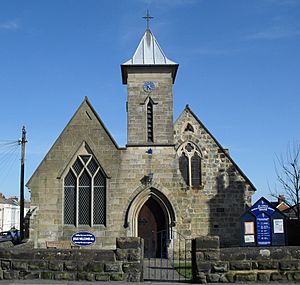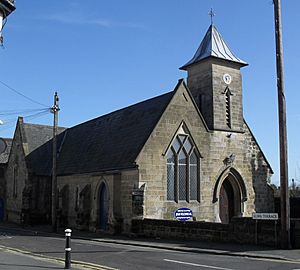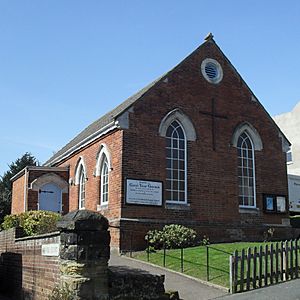St Luke's United Reformed Church, Silverhill, Hastings facts for kids
Quick facts for kids St Luke's Church |
|
|---|---|
| St Luke's United Reformed Church | |

The church from the west
|
|
| 50°52′10″N 0°33′26″E / 50.8695°N 0.5572°E | |
| Location | Sedlescombe Road North, Silverhill, Hastings, East Sussex TN37 6QT |
| Country | England |
| Denomination | United Reformed Church |
| Previous denomination | Presbyterian |
| History | |
| Former name(s) | Silverhill Independent Chapel; Silverhill Presbyterian Church |
| Status | Church |
| Founded | 1853 |
| Founder(s) | William Boyd |
| Dedication | Saint Luke |
| Dedicated | 1920s |
| Events | 1853: Congregation established at Providence Villa 1857: Silverhill Independent Chapel opened 1862: Chapel extended 1920s: Dedicated to St Luke 1972: Became part of United Reformed Church 1987: Building damaged in the Great Storm |
| Architecture | |
| Functional status | Active |
| Architect(s) | Henry Carpenter |
| Style | Early English Gothic |
| Groundbreaking | 1857 |
| Completed | 12 July 1857 |
| Construction cost | £370 (£24,600 in 2021) |
| Administration | |
| Synod | Southern Synod |
St Luke's Church is a United Reformed church located in Silverhill, a part of Hastings in East Sussex, England. It started in 1853 when people met in a private house. They were "independent," meaning they didn't belong to a specific Christian denomination.
By 1857, they had their own church building. This church became one of the oldest Presbyterian places of worship in southeast England. Over the years, the church has been made bigger several times. In 1987, a huge storm damaged the building, and it lost its tall, pointed roof called a spire. However, the church was quickly repaired. In 1972, it joined the United Reformed Church, a new group formed by different churches. Today, St Luke's is one of four United Reformed Churches in Hastings.
Contents
History of St Luke's Church
The area where St Luke's Church stands was once part of a large farm called Silver Hill Farm. In the early 1800s, Hastings and nearby St Leonards-on-Sea became popular seaside towns. New roads were built, and the Silver Hill area started to grow into a suburb. There were new buildings like a windmill, a hotel, and shops.
How the Church Started
In 1853, a man named William Boyd worked as a tutor at Silver Hill Farm. He was a member of the United Presbyterian Church of Scotland and had studied theology. Boyd noticed there were no churches nearby for the growing community. The closest churches were quite a distance away.
So, he decided to start his own church. A kind person let him use a room in their house, Providence Villa, for meetings. William Boyd's idea was very popular. By 1855, so many people came that the meetings had to move to a larger public building, possibly the local hotel.
Building the First Chapel
The meetings were "independent," meaning they weren't part of any official church group. Some local church leaders didn't like this and tried to stop people from attending. But William Boyd decided to build a permanent chapel anyway.
He gathered a group of eight trustees, who were people from different local churches who supported his idea. They started raising money. The landowner sold some land for £50. A local architect named Henry Carpenter designed the first chapel. It was built for £370 in just a few months in 1857. William Boyd held the first service at the Silver Hill Independent Chapel on July 12, 1857. A Sunday school for children started the next week with 30 kids.
Growth and Changes
From 1860, Silverhill grew even more with new houses and inns. The Anglican church also built their own church, St Matthew's Church, which opened in 1861.
By 1862, a new minister, Walter Roberts, took over at the Silver Hill chapel. Under his leadership, the church joined the English Presbyterian Church. The building was made bigger, costing £400. Even though some people went to the new Anglican church, the Silverhill Presbyterian Church (as it was now called) became very popular.
In 1865, more work was done. A tower and a tall, unique spire were added to the west end of the church. The main part of the church, called the nave, was also made wider. New things like a harmonium and a heating system were added. In 1878, a separate schoolroom was built next to the chapel for the Sunday school. This cost £296.
New Century, New Name
In 1907, the church started a "Jubilee Fund" to raise money for more improvements. By 1909, they had £700. The old schoolroom was replaced with a larger hall. A chancel (the area around the altar) was added to the chapel, and the inside was updated with new wooden fixtures and a stone font. The building also got electric lights for the first time. This work was finished in about 10 weeks.
In the 1920s, the church changed its name to St Luke's Presbyterian Church. They chose Luke from a list of three saints to give the church a more memorable name. In 1923, beautiful stained glass windows were added to remember people.
During World War II, the church helped the community. It was used as a shelter for people whose homes were bombed. The minister's house was also used by the army. When another Presbyterian church in St Leonards-on-Sea was destroyed by a bomb in 1942, its members joined St Luke's.
Joining the United Reformed Church
In 1972, St Luke's Church joined the new United Reformed Church group. This group was formed by different Presbyterian and Congregational churches joining together. The next year, members from the Red Lake Congregational Church joined St Luke's when their church closed.
For a while, St Luke's Church worked closely with St Mark's Church in Blacklands and another church in Rye. But after the Rye church closed in 1986, St Luke's managed its own affairs again.
The Great Storm of 1987
On the night of October 15-16, 1987, a huge storm, known as the Great Storm of 1987, hit Britain. St Luke's Church was badly damaged by the strong winds. Around 7:00 AM, the church's tall spire was ripped off the tower. It crashed through the roof of the church, sticking out dangerously.
After the storm, a crane had to lift the spire out of the church. It couldn't be saved. The church hall was used for services while repairs were made. Other churches in Hastings helped out, too. The rebuilding work, which included a new vestry and a bigger kitchen, was finished by April 29, 1990. The tower was rebuilt, and a much smaller, cap-shaped spire was put in place of the old one.
In 2000, a clock was added to the front wall of the tower to celebrate the new millennium. A new wooden font was donated in 2003.
Architecture of St Luke's Church
The church building was designed by Henry Carpenter in 1857. Even though it has been added to many times, it still looks like an Early English Gothic building. It is made entirely of stone.
The church has a tower at the west end, which now has a low, pyramid-shaped spire. It also has a main area called a nave with aisles, a chancel, a wooden porch, a vestry, a kitchen, and a large hall attached. Most of the windows are tall and narrow, called lancet windows. Some of them have beautiful stained glass.
St Luke's Church Today
As of 2010, St Luke's Church was one of four United Reformed churches in Hastings. The others were St Mark's Church, Clive Vale United Reformed Church, and Robertson Street United Reformed Church in Hastings town centre. However, Robertson Street United Reformed Church closed in 2012.
All these churches belong to the Southern Synod, which is one of 13 groups that manage United Reformed churches in different parts of Great Britain.
A local historian, J. Manwaring Baines, thought that Silverhill Independent Chapel (now St Luke's) was a very important church built in Hastings during the 1800s. He admired its determination to overcome challenges. When it joined the Presbyterian church in 1862, it became one of the first Presbyterian churches in southeast England.
On October 5, 1972, the church officially joined the new United Reformed Church group. It has been known as St Luke's United Reformed Church ever since. The church is officially registered as a place of worship.
See also




